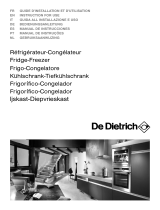
21
Before contacting the After-Sales Service:
1. See if you can solve the problem yourself
with the help of the Trouble-shooting guide.
2. Switch the appliance off and then on again
to check if the problem has been eliminated.
If it has not, switch off the appliance again
and repeat the operation after one hour.
3. If the problem persists after this course of
action, contact After-sales Service.
Specify:
• the type of fault
• the appliance model
• The Service number (the number after the
word SERVICE on the rating plate inside the
appliance)
• Your full address
• Your telephone number and area code
Note:
The direction of door opening can be
changed. If this operation is performed by
After-sales Service it is not covered by the
warranty.
AFTER-SALES SERVICE
• Install the appliance away from heat
sources. Installation in a hot environment,
direct exposure to the sun or installation near
heat sources (heaters, radiators, cookers)
will increase power consumption and should
therefore be avoided.
• If this is not possible, the following minimum
distances must be respected:
- 30 cm from coal or paraffin stoves;
- 3 cm from electric and/or gas stoves.
• Fit the spacers (if supplied) on the rear of
the condenser positioned at the back of the
appliance.
• Install the appliance in a dry, well-ventilated
place, and ensure it is level, using the front
adjustment feet if necessary.
• Clean the interior.
• Fit the accessories.
Electrical connection
• Electrical connections must be made in
accordance with local regulations.
• Voltage and power consumption are
indicated on the rating plate inside the
appliance.
• Regulations require that the appliance
be earthed. The manufacturer declines
all liability for injury to persons or
animals and for damage to property
resulting from failure to observe the
above procedures and reminders.
• If the plug and socket are not of the same
type, have the socket replaced by a qualified
electrician.
• Do not use extension leads or adapters.
Disconnecting the appliance
It must be possible to disconnect the appliance
by unplugging it or by means of a two-pole
switch fitted upline of the socket.
INSTALLATION

















